An overview of neovaginal reconstruction options in male to female transsexuals
- PMID: 24971387
- PMCID: PMC4058296
- DOI: 10.1155/2014/638919
An overview of neovaginal reconstruction options in male to female transsexuals
Abstract
Transsexualism is a complex condition in which the person experiences the inconsistency between the desired gender and their biological gender. Absence of the vagina is devastating in male to female transsexuals. Creation of the neovagina is the main surgical problem in these patients. Historically, beginnings of the neovaginal creation have their roots in the treatment of Mayer-Rokitansky syndrome and conditions such as cloacal anomalies, certain intersex disorders, vaginal malignancies, or severe vaginal trauma, but have more recently found great purpose in male to female sex reassignment surgery. Many operative procedures have been described but none is ideal. Therefore, the search for new, improved solutions continues. In neovaginoplasty reconstruction of the vulvovaginal complex is performed in its entity. The gold standard in neovaginal reconstruction in male to female sex reassignment surgery is penile skin inversion technique with or without scrotal flaps, which enables adequate sensation of the neovagina, good neovaginal depth, good erotic sensitivity of the neclitoris, and esthetically acceptable labia minora and maiora.
Figures

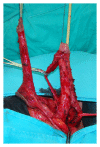

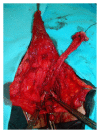

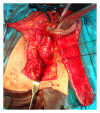
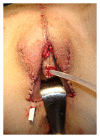

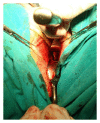
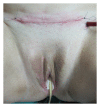
Similar articles
-
Surgical reconstruction for male-to-female sex reassignment.Eur Urol. 2013 Jul;64(1):141-9. doi: 10.1016/j.eururo.2012.12.030. Epub 2013 Jan 5. Eur Urol. 2013. PMID: 23375962
-
The Bilateral Pedicled Epilated Scrotal Flap: A Powerful Adjunctive for Creation of More Neovaginal Depth in Penile Inversion Vaginoplasty.J Sex Med. 2020 May;17(5):1033-1040. doi: 10.1016/j.jsxm.2020.02.024. Epub 2020 Mar 20. J Sex Med. 2020. PMID: 32205085
-
Vaginal Canal Reconstruction in Penile Inversion Vaginoplasty with Flaps, Peritoneum, or Skin Grafts: Where Is the Evidence?Plast Reconstr Surg. 2021 Apr 1;147(4):634e-643e. doi: 10.1097/PRS.0000000000007779. Plast Reconstr Surg. 2021. PMID: 33776039
-
Laparoscopic sacrocolpopexy for neovaginal prolapse in a patient after male-to-female sex reassignment surgery.Int Braz J Urol. 2019 May-Jun;45(3):643-644. doi: 10.1590/S1677-5538.IBJU.2018.0086. Int Braz J Urol. 2019. PMID: 30735335 Free PMC article.
-
[Gender reassignment surgery from male to female].Urologe A. 2020 Nov;59(11):1348-1355. doi: 10.1007/s00120-020-01337-z. Urologe A. 2020. PMID: 32980880 Review. German.
Cited by
-
Medical dermatologic conditions in transgender women.Int J Womens Dermatol. 2018 Oct 11;4(4):212-215. doi: 10.1016/j.ijwd.2018.08.008. eCollection 2018 Dec. Int J Womens Dermatol. 2018. PMID: 30627619 Free PMC article. Review.
-
Gender-Affirming Surgery and Cancer: Considerations for Radiation Oncologists for Pelvic Radiation in Transfeminine Patients.Int J Radiat Oncol Biol Phys. 2023 Oct 1;117(2):301-311. doi: 10.1016/j.ijrobp.2023.05.028. Epub 2023 May 24. Int J Radiat Oncol Biol Phys. 2023. PMID: 37230432 Free PMC article. Review.
-
[Psychiatric, socio-legal and perioperative aspects of vaginoplasty].Urologie. 2024 Jan;63(1):51-57. doi: 10.1007/s00120-023-02244-9. Epub 2023 Dec 29. Urologie. 2024. PMID: 38157067 Review. German.
-
The Effect of Gender-Affirming Medical Care on the Vaginal and Neovaginal Microbiomes of Transgender and Gender-Diverse People.Front Cell Infect Microbiol. 2022 Jan 21;11:769950. doi: 10.3389/fcimb.2021.769950. eCollection 2021. Front Cell Infect Microbiol. 2022. PMID: 35127550 Free PMC article. Review.
-
Squamous Carcinoma of the Neovagina after Male-to-Female Reconstruction Surgery: A Case Report and Review of the Literature.Case Rep Obstet Gynecol. 2019 Jan 16;2019:4820396. doi: 10.1155/2019/4820396. eCollection 2019. Case Rep Obstet Gynecol. 2019. PMID: 30775041 Free PMC article.
References
-
- WHO. International Statistical Classification of Diseases and Related Problems. 2nd edition. Geneva, Switzerland: WHO; 2005. (10th Revision).
-
- van Kesteren PJ, Gooren LJ, Megens JA. An epidemiological and demographic study of transsexuals in the Netherlands. Archives of Sexual Behavior. 1996;25(6):589–600. - PubMed
-
- Garrels L, Köckott G, Michael N, et al. Sex ratio of transsexuals in Germany: the development over three decades. Acta Psychiatrica Scandinavica. 2000;102(6):445–448. - PubMed
-
- de Cuypere G, van Hemelrijck M, Michel A, et al. Prevalence and demography of transsexualism in Belgium. European Psychiatry. 2007;22(3):137–141. - PubMed
-
- Veale JF. Prevalence of transsexualism among New Zealand passport holders. Australian and New Zealand Journal of Psychiatry. 2008;42(10):887–889. - PubMed
Publication types
MeSH terms
LinkOut - more resources
Full Text Sources
Other Literature Sources

